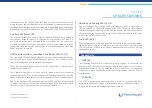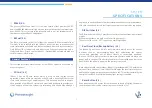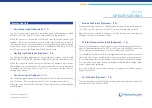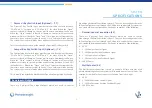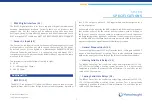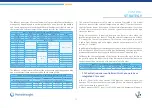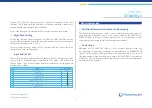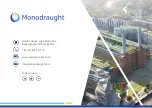
www.monodraught.com
info@monodraught.com
9
RS485 Digital Interface (8.3)
BMS I/O (9.1)
General Purpose Inputs (9.2)
Heating Solid State Relays (9.3)
Cooling Solid State Relays (9.4)
Sensor 1/2 Input (8.4)
The RS485 Digital Interface is for future support of digital communication
between Monodraught products. Currently there are no products that
support this, but this section will be updated when they have been
developed. Currently it provides 24V power and an RS485 connection over a
RJ45 terminated CAT5 cable, but MUST NOT BE CONFUSED WITH ETHERNET.
The BMS I/O connections (J17) allow the iNVent 2 panel to send or receive
signals to/from a BMS system for tighter control and integration. It provides
The general purpose inputs (J21 & J25) provide four 0 - 10V inputs and 24V DC
power to additional devices or sensors. These can be configured to operate
with a wide variety of sensors through the iNVent 2 configurator software.
The iNVent 2 panel has four solid state relays (Lower terminals of J15, J18,
J22, J26) for controlling a heating system per zone. This is not currently
supported, but will be in a future release of firmware. It is a volt-free contact
rated at 24V, 1A maximum.
The iNVent 2 panel has four solid state relays (Upper terminals of J15, J18,
J22, J26) for controlling a cooling system per zone. This is not currently
supported, but will be in a future release of firmware. It is a volt-free contact
rated at 24V, 1A maximum.
The Sensor 1 and 2 inputs are used to connect to Monodraught sensors and
wall controllers, as well as any other sensors that output a 0-10V signal.
By default, Sensor 1 is configured as a Monodraught WINDCATCHER Wall
Mounted Controller, and Sensor 2 is configured as an additional 0-50°C
temperature sensor. This means that by default, iNVent 2 operates the same
way as an iNVent 1 panel.
The terminals are wired as follows, from left to right:
1.
0V DC
2.
0 - 10V Input from Sensor
3.
24V DC Power
SYSTEM
SPECIFICATIONS
four 0 - 10V outputs, and four 0 - 10V inputs which can be configured for a
variety of purposes.
An example of this is getting the BMS system to send the room temperature
that it reads and uses for the control of other systems, such as heating, to
the iNVent 2 panel so that one common measurement is used to prevent
cooling/heating system fighting or oscillation. It can also operate in reverse,
so that the BMS uses the temperature measurements that the iNVent 2 panel
measures to base the operation of other building systems on.
Additional I/O





